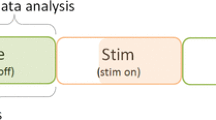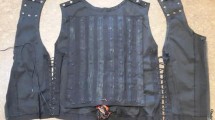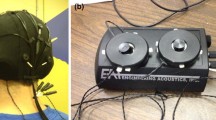Abstract
Our previous work revealed that torso cutaneous information contributes to the internal representation of the torso and plays a role in postural control. Hence, the aims of this study were to assess whether posture could be manipulated by patterns of vibrotactile stimulation and to determine whether resulting modified postures were associated with specific and consistent spatial attitudes. Ten healthy young adults stood in normal and Romberg stances with six vibrating actuators positioned on the torso in contact with the skin over the anatomical locations corresponding to left and right external oblique, internal oblique and erector spinae muscles at the L4/L5 vertebrae level. A 250-Hz tactile vibration was applied for 5 s either at a single location or consecutively at each location in clockwise or counterclockwise sequences. Kinematic analysis of the body segments indicated that postural responses observed in response to single and sequential stimulation patterns were similar, while the center of pressure remained unaltered in any situations. Moreover, torso inclinations followed rectilinear-like path segments chartered by stimuli loci during sequential stimulations. Comparison of torso attitudes with previous results obtained with co-vibration patterns of the same duration showed that torso inclination amplitudes are equivalent for single (one location) and co-vibration (pairs of locations) patterns inducing the same directional effect. Hence, torso cutaneous information exhibits kinesthetic properties, appears to provide a map of upper body spatial configuration, and could assume the role of an internal positioning system for the upper body.




Similar content being viewed by others
References
Aimonetti JM, Hospod V, Roll JP, Ribot-Ciscar E (2007) Cutaneous afferents provide a neuronal population vector that encodes the orientation of human ankle movements. J Physiol 580:649–658
Aimonetti JM, Roll JP, Hospod V, Ribot-Ciscar E (2012) Ankle joint movements are encoded by both cutaneous and muscle afferents in humans. Exp Brain Res 221:167–176. doi:10.1007/s00221-012-3160-2
Bernstein NA (1967) The co-ordination and regulation of movements. Pergamon Press, Oxford
Blanchard C, Roll R, Roll JP, Kavounoudias A (2011) Combined contribution of tactile and proprioceptive feedback to hand movement perception. Brain Res 1382:219–229. doi:10.1016/j.brainres.2011.01.066
Blanchard C, Roll R, Roll JP, Kavounoudias A (2013) Differential contributions of vision, touch and muscle proprioception to the coding of hand movements. PLoS One 8:e62475. doi:10.1371/journal.pone.0062475
Collins DF, Refshauge KM, Todd G, Gandevia SC (2005) Cutaneous receptors contribute to kinesthesia at the index finger, elbow, and knee. J Neurophysiol 94:1699–1706. doi:10.1152/jn.00191.2005
Edin B (2001) Cutaneous afferents provide information about knee joint movements in humans. J Physiol 531:289–297
Forssberg H, Nashner LM (1982) Ontogenetic development of postural control in man: adaptation to altered support and visual conditions during stance. J Neurosci 2:545–552
Gandevia SC, Hall LA, McCloskey DI, Potter EK (1983) Proprioceptive sensation at the terminal joint of the middle finger. J Physiol 335:507–517
Gandevia SC, McCloskey DI, Burke D (1992) Kinaesthetic signals and muscle contraction. Trends Neurosci 15:62–65
Gao JH, Parsons LM, Bower JM, Xiong J, Li J, Fox PT (1996) Cerebellum implicated in sensory acquisition and discrimination rather than motor control. Science 272:545–547
Goodwin GM, McCloskey DI, Matthews PB (1972) The contribution of muscle afferents to kinaesthesia shown by vibration induced illusions of movement and by the effects of paralysing joint afferents. Brain 95:705–748
Ivanenko YP, Talis VL, Kazennikov OV (1999) Support stability influences postural responses to muscle vibration in humans. Eur J Neurosci 11:647–654
Jagacinski RJ, Flach JM (2003) Control theory for humans: quantitative approaches to modeling performance. Lawrence Erlbaum Associates, Mahwah
Katayama M, Kawato M (1993) Virtual trajectory and stiffness ellipse during multijoint arm movement predicted by neural inverse models. Biol Cybern 69:353–362
Kavounoudias A, Gilhodes JC, Roll R, Roll JP (1999a) From balance regulation to body orientation: two goals for muscle proprioceptive information processing? Exp Brain Res 124:80–88
Kavounoudias A, Roll R, Roll JP (1999b) Specific whole-body shifts induced by frequency-modulated vibrations of human plantar soles. Neurosci Lett 266:181–184
Kavounoudias A, Roll R, Roll JP (2001) Foot sole and ankle muscle inputs contribute jointly to human erect posture regulation. J Physiol 532:869–878
Lackner JR (1988) Some proprioceptive influences on the perceptual representation of body shape and orientation. Brain 111(Pt 2):281–297
Lackner JR, Levine MS (1979) Changes in apparent body orientation and sensory localization induced by vibration of postural muscles: vibratory myesthetic illusions. Aviat Space Environ Med 50:346–354
Lackner JR, Rabin E, DiZio P (2000) Fingertip contact suppresses the destabilizing influence of leg muscle vibration. J Neurophysiol 84:2217–2224
Lee BC, Martin BJ, Sienko KH (2012) Directional postural responses induced by vibrotactile stimulations applied to the torso. Exp Brain Res 222:471–482. doi:10.1007/s00221-012-3233-2
Lee BC, Martin BJ, Ho A, Sienko KH (2013a) Postural reorganization induced by torso cutaneous covibration. J Neurosci 33:7870–7876. doi:10.1523/JNEUROSCI.4715-12.2013
Lee BC, Martin BJ, Sienko KH (2013b) The effects of actuator selection on non-volitional postural responses to torso-based vibrotactile stimulation. J Neuroeng Rehabil 10:21. doi:10.1186/1743-0003-10-21
Martin BJ, Gauthier GM, Roll JP, Hugon M, Harlay F (1980) Effects of whole-body vibrations on standing posture in man. Aviat Space Environ Med 51:778–787
Plato (1966) Phaedo. Harvard University Press, Cambridge
Proske U, Gandevia SC (2012) The proprioceptive senses: their roles in signaling body shape, body position and movement, and muscle force. Physiol Rev 92:1651–1697. doi:10.1152/physrev.00048.2011
Roll JP, Roll R (1988) From eye to foot: a proprioceptive chain involved in postural control. Elsevier, Amsterdam
Roll JP, Vedel JP (1982) Kinaesthetic role of muscle afferents in man, studied by tendon vibration and microneurography. Exp Brain Res 47:177–190
Roll JP, Vedel JP, Ribot E (1989a) Alteration of proprioceptive messages induced by tendon vibration in man: a microneurographic study. Exp Brain Res 76:213–222
Roll JP, Vedel JP, Roll R (1989b) Eye, head and skeletal muscle spindle feedback in the elaboration of body references. Prog Brain Res 80:113–123 (discussion 157–160)
Roll R, Kavounoudias A, Roll JP (2002) Cutaneous afferents from human plantar sole contribute to body posture awareness. Neuroreport 13:1957–1961
Roll JP, Albert F, Thyrion C, Ribot-Ciscar E, Bergenheim M, Mattei B (2009) Inducing any virtual two-dimensional movement in humans by applying muscle tendon vibration. J Neurophysiol 101:816–823
Schweighofer N, Arbib MA, Kawato M (1998) Role of the cerebellum in reaching movements in humans. I. Distributed inverse dynamics control. Eur J Neurosci 10:86–94
Sienko KH, Vichare VV, Balkwill MD, Wall C 3rd (2010) Assessment of vibrotactile feedback on postural stability during pseudorandom multidirectional platform motion. IEEE Trans Biomed Eng 57:944–952. doi:10.1109/TBME.2009.2036833
Sienko KH, Balkwill MD, Wall C (2012) Biofeedback improves postural control recovery from multi-axis discrete perturbations. J Neuroeng Rehabil 9. doi:10.1186/1743-0003-9-53
Slijper H, Latash ML (2004) The effects of muscle vibration on anticipatory postural adjustments. Brain Res 1015:57–72
Verrel J, Cuisinier R, Lindenberger U, Vuillerme N (2011) Local and global effects of neck muscle vibration during stabilization of upright standing. Exp Brain Res 210:313–324. doi:10.1007/s00221-011-2636-9
Wall PD, Noordenbos W (1977) Sensory functions which remain in man after complete transection of dorsal columns. Brain 100:641–653
Weerakkody NS, Mahns DA, Taylor JL, Gandevia SC (2007) Impairment of human proprioception by high-frequency cutaneous vibration. J Physiol 581:971–980. doi:10.1113/jphysiol.2006.126854
Winter DA, Patla AE, Prince F, Ishac M, Gielo-Perczak K (1998) Stiffness control of balance in quiet standing. J Neurophysiol 80(3):1211–1221
Acknowledgments
This work was supported by the National Science Foundation’s GARDE program (Grant No. 0846471 to K. Sienko). The authors acknowledge the Center for Statistical Consultation and Research at University of Michigan for their consultation regarding statistical analysis. We also thank Eyvind Claxton1 for his contribution to iconography.
Author information
Authors and Affiliations
Corresponding author
Rights and permissions
About this article
Cite this article
Martin, B.J., Lee, BC. & Sienko, K.H. A cutaneous positioning system. Exp Brain Res 233, 1237–1245 (2015). https://doi.org/10.1007/s00221-014-4194-4
Received:
Accepted:
Published:
Issue Date:
DOI: https://doi.org/10.1007/s00221-014-4194-4




